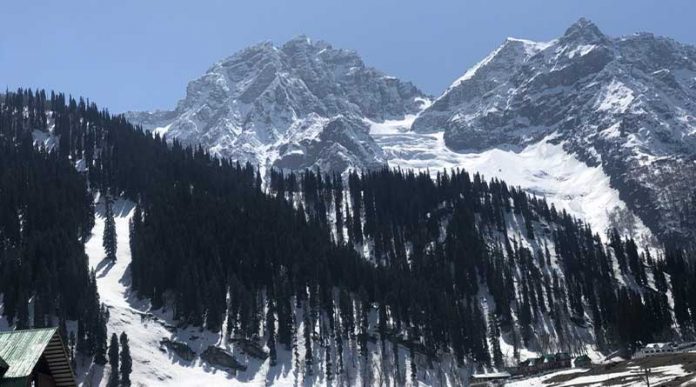Amidst the conflict, the tourism industry of Indian administered Kashmir remains an important part of the economy of the region
By Malika Kaloo
Agar Firdaus bar roo-e zameen ast,
Hameen ast-o hameen ast-o hameen ast-o.
[If there is a paradise on earth,
It is this, it is this, it is this.]
Tall snow-clad mountains, glistening rivers and dark green forests of Kashmir mesmerized Mughal emperor Jahangir so much that he used this Persian couplet by Sufi saint Amir Khusrau to describe the beauty of this region.
In the lap of the Himalayas and the Pir Panjal Range, the valley of Kashmir is renowned for its beauty all over the globe. Its summer capital is one of the few cities in the world with mountains, rivers and lakes all within its boundaries.
Despite the uncertain political situation and unrest, the tourism industry of Kashmir is a major contributor to its economy.
Kashmiris are known for their hospitality, rich culture and delicious cuisine. The traditions are often considered to be a blend of Central and South Asian cultures.
Often termed as “Switzerland of Asia,” Kashmir is home to some of the most beautiful hill stations like Gulmarg, Pahalgam and Sonamarg, Asia’s largest freshwater lake, Asia’s largest tulip garden, historical sites, Mughal-era gardens and Sufi shrines.
Surrounded by mountains and boulevards, Dal Lake is another major tourist attraction in Kashmir. One of the most visited places in Srinagar, Dal is usually packed with houseboats (boats designed as houses), shikaras (a small light boat) and a floating vegetable market.
Before the start of the uprising in the 1990s, Kashmir used to be the most preferred destination for the filming of big-budget Bollywood movies.
According to Mushtaq Chaya, chairman of the Jammu and Kashmir Hoteliers Club, the tourism industry in Kashmir has immense potential to become a major global tourist attraction but it requires further exploration.
“The weather here is favorable for leisure activities like in winters, white-powdered mountains of Kashmir are perfect for skiing. Given the beautiful locales of the valley, we have enough resources to keep tourists interested throughout the year,” he adds.
Although Indian administered Kashmir is one of the most militarized zones in the world, this Himalayan region witnesses an influx of tourists from different countries. However, the numbers even may vary from year to year depending on the political situation.
The importance of tourism in our economy has been known for decades now. Its role in economic development has been an area of great interest from a policy perspective,” says Mushtaq Chaya.
“Kashmir is blessed with rich flora and fauna, along with picturesque landscape, cultural richness and pilgrimage destinations. It also provides tourists from all over the world with opportunities such as eco-tourism, pilgrimage tourism, adventure tourism and even medical tourism,” says Sajid Farooq Shah, an entrepreneur interested in hospitality and real estate development business.
“Around 50-60% of the total population of Jammu and Kashmir is directly or indirectly engaged in tourism-related activities. Tourism contributes about 15% to state gross domestic product,” adds Shah.
“The flow of tourists to the valley has been dependent on the law and order situation. The maintenance of a cordial and peaceful environment will encourage more tourists to visit Kashmir,” says Sajid Farooq Shah.
Abdul Wahid, president of Kashmir Hotels and Restaurant Owners Federation, says over the years, there has been a decrease in foreign tourists due to the situation in Kashmir and it has resulted in a change in planning and promotional activities.
“Earlier, our focus was on getting foreign tourists but unfortunately, many countries have imposed advisories against travelling to Kashmir,” says Wahid.
Interestingly, despite the turmoil, Kashmir remains one of the safest destinations in India for foreign tourists with no crime recorded against them from at least 2016 to 2020, according to the report of the National Crime Bureau of India.
The hospitality industry of Kashmir has suffered massive losses because of frequent incidents of violence, shutdowns and curfews.
Ironically, violence in the conflict-ridden region usually coincides with the peak of the tourism season. Whenever political condition deteriorates, initial repercussions include the cancellation of flights and hotel bookings owing to panic and uncertainty that, almost always, immediately grips the valley.
“Tourism sector is the biggest victim of conflict. We have not been able to tap even 10% of our potential. If the situation would have been normal, this sector could have expanded its operations,” says Showkat Chowdhary, chairman of Jammu and Kashmir Hotels and Restaurants Association.
Businesses associated with tourism record fluctuations in their growth as peace and normalcy cannot be guaranteed in Kashmir.
The question that arises is how can this industry survive amidst the current situation?
The common idea put forth by people dependent on tourism for their livelihoods is that unexplored areas should be unraveled, and Kashmir should be promoted internationally as a “world-class tourist destination.”
“This year, the government has identified 75 off-beat destinations. However, they must be brought into the itinerary of tourists visiting Kashmir in order to boost tourism,” says Ather Yameen, a travel agent.
“The second thing is that the budgetary allocation for promotion of tourism activities must be increased so that there is enough buzz about the place across the markets from where we can reach our potential clients.”
Even as Kashmir remains in the news for all the unfortunate developments, the world needs to see the positive side of the story, take a glimpse of Kashmiri hospitality and visit this piece of heaven at least once in their lives.





















